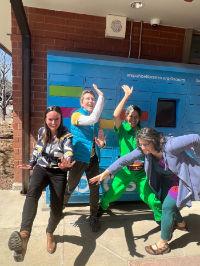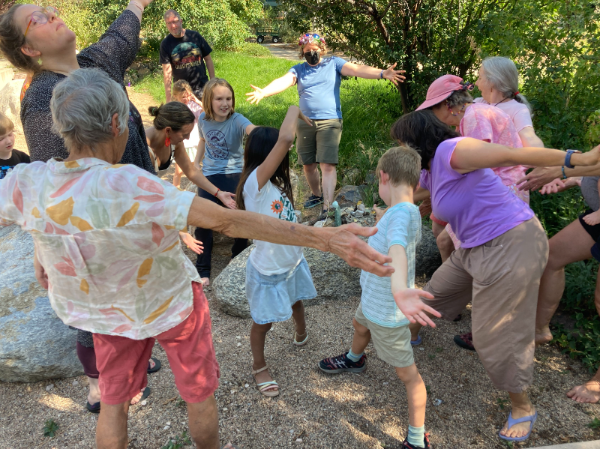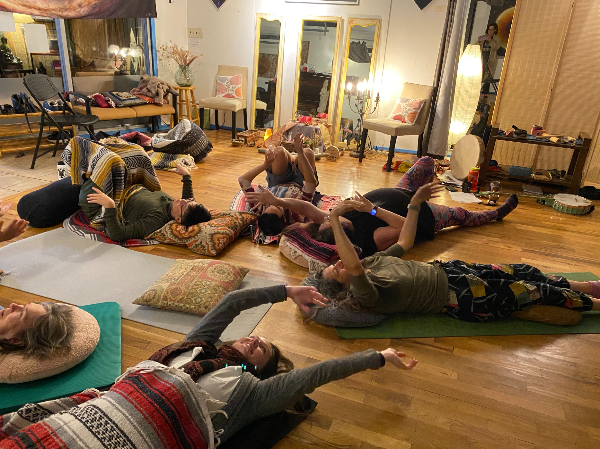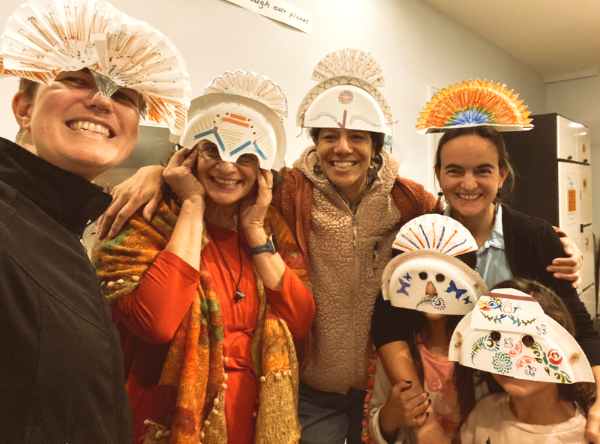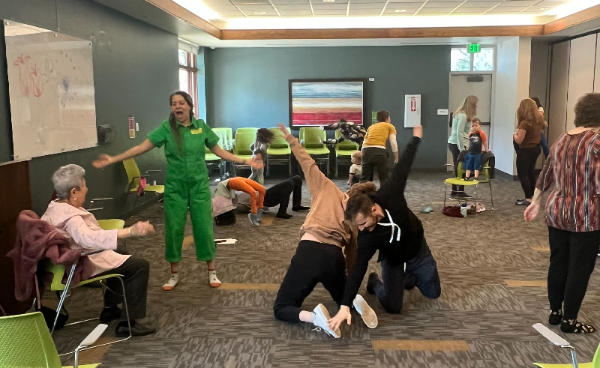What is InterPlay?
InterPlay is an embodied practice combining playful movement, storytelling, and music that can be adapted to all ages and bodies. Our local team of facilitators offer workshops for community resilience in Colorado, which is especially needed during these times. We would love to partner with your group or organization to offer a play series as part of your programs in support of community-building, spiritual practice, ecological justice, and social change. Research has shown that play is a powerful way to rewire our brains, relieve stress, enhance learning, and build resilience. Using simple exercises that build incrementally, participants are invited to gradually engage their creative energies to express themselves and unlock the wisdom inside the body.
About InterPlay
InterPlay is a 35 year old nonprofit organization started by Cynthia Winton-Henry and Phil Porter, and our “playshops” are utilized by organizations in the churches, justice, education, library, healthcare and other sectors throughout North America and around the world. InterPlay workshops are facilitated in a trauma-informed method, and support greater awareness of our mental and physical health. This ultimately leads participants to make healthier decisions for their lifestyles, all from the wisdom of their body. Our local team works as Gather The Wild Collective / InterPlay Colorado and includes ministers, social workers, educators, a librarian, and a healthcare practitioner. Our facilitation team includes BIPOC, Spanish-speaking, and Queer identities. We’re equipped to support a range of social identities, lived experiences, and individual and community needs. Our values center a deep commitment to equity, nature-based, and social justice work, with a focus on offering workshops for and with marginalized communities that support wellbeing, restoring connection to the natural world, and social change.
One participant at a recent event wrote us about the impact of their InterPlay experience as an embodied homecoming, “reconnecting with early sensations & lost body wisdoms,” and realizing that “the movement & vocalizing is respectable & so natural to my being.” Another shared, “The Interplay retreat helped me to free my body and mind from judgment.”
InterPlay Colorado Media
It can be hard to get a sense of the essence of InterPlay before you experience it for yourself! These clips can give a little more of an idea of what some of the InterPlay forms might look like.
Clips from our All Ages Playshop in March 2024
Clips from the Spirit of Play Mini-retreat in December 2024
Short video of an InterPlay form, Following & Leading at a Young Adult Meditation Retreat in San Diego, CA, 2023.
Drawing on movement, vocalization, sounds, rhythm, music, improvisation, storytelling, and stillness, InterPlay engages all of the senses, supporting both the mind and body integratively. Researchers are finding that physical movement and dance support brain plasticity that help us repair, integrate, and rewrite our inner narratives of traumatic experiences (Perry, 2015). Dance and movement experiences are both creative arts-based and somatic experiences that can support resilience and well-being. In her book, Trauma and Expressive Arts Therapy, Dr. Cathy Malchiodi writes eloquently about the integration of creative arts to support recovery from traumatic experiences, “There has been relatively little cross-fertilization between creative arts therapies approaches in terms of practice, education and research because each creative arts therapy has carved out a circumscribed domain and educational standards. In reality, there are many important commonalities across these approaches that complement each other and are necessary to effective applications of arts-based strategies in work with traumatized individuals. To me, it is the integrative synergy of the arts, based on cultural traditions and current trauma-informed practice, that is requisite to addressing traumatic stress with most children, adults, families, groups, and communities” (2020, p. 18). For over forty years, InterPlay Leaders have been integrating these creative approaches to support players of all ages and abilities in ‘dancing life’s difficult dances’ to meet trauma, aging, loss, death, -isms, and change. InterPlay leaders have also trained specifically in the range of modalities and in sequencing them most effectively and incrementally to support individuals and groups in creative expression and playful release of stress and tension. Rather than using the arts to focus solely on beauty or excellence in performance, InterPlay brings these creative forms together for us to play with our truths and lived experiences in ways that give us greater access to our aliveness.
Creative arts have been found to help with stress prevention and stress management (Martin et al, 2018). Group sessions have been particularly effective for helping individuals with traumatic histories who engaged in music therapy (Landis-Shack, Heinz, and Bonn-Miller, 2017). Rhythm, chanting and movement have all been found to benefit people with significant traumatic experiences (van Der Kolk, 2014). Art-making has been found to help increase feelings of safety, positive emotions, and relationship connections among veterans with PTSD (Spiegel, Malchiodi, Backos, & Collie, 2006). Mindfulness based interventions and creative writing have also been found to support trauma repair (van Der Kolk, 2014).
Yes! Perry writes “Amid the current pressure for “evidence-based practice” parameters, we should remind ourselves that the most powerful evidence is that which comes from hundreds of separate cultures across thousands of generations independently converging on rhythm, touch, storytelling, and reconnection to community…as the core ingredients to coping and healing from trauma” (2015, p. xii). Art therapist Cathy Malchiodi writes, “the combined use of the arts for health well-being, including the amelioration of trauma, is not something new; it is part of humankind’s collective history to use art, music and sound, movement and dance, dramatic enactment, and other forms of imagination in response to trauma and loss” (2020, p. 18).
References
Landis-Shack, N. Heinz, A.J., and Bonn-Miller, M.O. (2017). Music therapy for post-traumatic stress in adults: A theoretical review. Psychomusicology: Music, mind, and brain, 27(4), 334-342.
Malchiodi, C.A. (2020). Trauma and expressive arts therapy: Brain, body and imagination in the healing process. New York: Guildford Press.
Martin, L., Oepen, R, Bauer, K., Nottensteiner, A., Mergheim, K., Gruber, H., et al. (2018). Creative arts interventions for stress management and prevention: A systematic review. Behavioral sciences (Basel, Switzerland), 8(2), E28.
Pennebaker, J.W. & Chung, C.K. (2011). Expressive writing and its links to mental and physical health. In H.S. Friedman (Ed.), Oxford handbook of health psychology (p. 417-437). New York: Oxford University Press.
Perry, B.D. (2015). Foreword. In C.A. Malchiodi (Ed.), Creative interventions with traumatized children (2nd ed, pp. ix-xi). New York: Guilford Press.
Spiegel, D., Malchiodi, C.A., Backos, A. & Collie, K.( 2006). Art therapy for combat-related PTSD: Recommendations for research and practice. Art Therapy 23(4), 157-164.
Van Der Kolk, B. (2014). The body keeps the score: Brain, mind and body in the healing of trauma. New York: Penguin.
